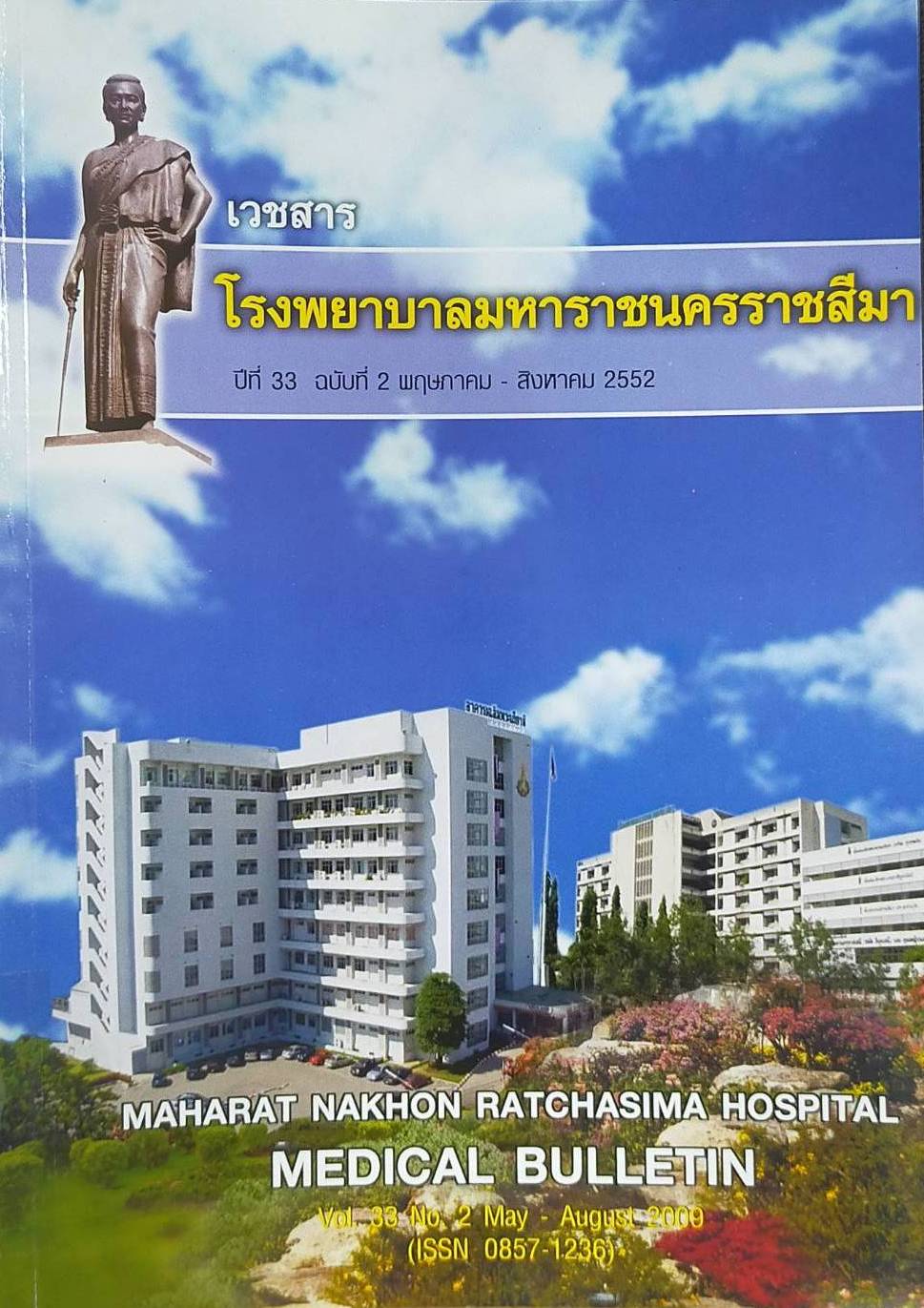ภาพรังสีเอกซเรย์คอมพิวเตอร์ที่พบไม่บ่อยและตำแหน่งที่พบไม่บ่อยของเนื้องอกเยื่อหุ้มสมองในโรงพยาบาลมหาราชนครราชสีมา
Main Article Content
บทคัดย่อ
วัตถุประสงค์: เพื่อศึกษาภาพรังสีเอกซเรย์คอมพิวเตอร์ที่พบไม่บ่อยและตำแหน่งที่พบไม่บ่อยของเนื้องอกเยื่อหุ้มสมองในโรงพยาบาลมหาราชนครราชสีมา ผู้ป่วยและวิธีการ: เป็นการศึกษาโดยวิธีพรรณนาย้อนหลังในผู้ป่วยเนื้องอกเยื่อหุ้มสมองที่มีผลยืนยันทางพยาธิวิทยาในโรงพยาบาลมหาราชนครราชสีมา ตั้งแต่วันที่ 1 มกราคม 2549 ถึงวัน ที่ 31 ธันวาคม 2551 นำข้อมูลเพศ อายุ เอกซเรย์คอมพิวเตอร์สมองมาศึกษา ซึ่งจะดูตำแหน่งของเนื้องอก ขนาดและลักษณะทางกายภาพและการจับสารทึบรังสี ผลการศึกษา: พบผู้ป่วยที่มีภาพรังสีเอกซเรย์คอมพิวเตอร์ที่พบไม่บ่อยและตำแหน่งที่พบไม่บ่อย 24 ราย เป็นชาย 5 ราย หญิง 19 ราย อายุเฉลี่ย 50.0+12.0 ปี พิสัย 31-79 ปี ซึ่งลักษณะภาพรังสีเอกซเรย์คอมพิวเตอร์ที่พบไม่บ่อย 20 รายได้แก่ เนื้องอกที่มีเนื้อตาย 4 ราย (ร้อยละ 20) มีเลือดออกในก้อนเนื้องอก 4 ราย (ร้อยละ 20) เนื้องอกที่เป็นถุงน้ำ 4 ราย (ร้อยละ 20) มีการจับสารทึบรังสีบริเวณขอบเนื้องอก 3 ราย (ร้อยละ15) เนื้องอกที่พบหลาย ๆ ตำแหน่ง 2 ราย (ร้อยละ 10) เนื้องอกที่มีลักษณะแบน (en plaque meningioma) 2 ราย (ร้อยละ10) เนื้องอกที่ทำลายกระดูกที่อยู่ข้างเคียง 1 ราย (ร้อยละ5.0) และเนื้องอกที่อยู่ในตำแหน่งที่พบไม่บ่อย 8 ราย คือ อยู่ในโพรงสมอง 4 ราย (ร้อยละ50) cerebellopontine angle 3 ราย (ร้อยละ37.5) และ ในตา 1 ราย (ร้อยละ 12.5) ในจำนวนนี้มีผู้ป่วย 4 รายที่มีทั้งลักษณะภาพรังสีที่พบไม่บ่อยและตำแหน่งที่พบไม่บ่อย สรุป: ภาพรังสีเอกซเรย์คอมพิวเตอร์ที่พบไม่บ่อยและตำแหน่งที่พบไม่บ่อยของเนื้องอกเยื่อหุ้มสมองในโรงพยาบาลมหาราชนครราชสีมา พบได้ร้อยละ 24.0 ส่วนใหญ่เป็นเพศหญิง อายุเฉลี่ย 50.0+12.0 ปี โดยลักษณะภาพรังสีเอกซเรย์คอมพิวเตอร์ที่พบไม่บ่อย ได้แก่ เนื้องอกที่มีเนื้อตาย, มีเลือดออกในก้อนเนื้องอก, เนื้องอกที่เป็นถุงน้ำและมีการจับสารทึบรังสีบริเวณขอบเนื้องอก ร้อยละ 20, 20, 20 และ 15 ตามลำดับ โดยเนื้องอกที่อยู่ในตำแหน่งที่พบไม่บ่อย ได้แก่ในโพรงสมองและ cerebellopontine angle ร้อยละ 50 และ 37.5 ตามลำดับ
Article Details

อนุญาตภายใต้เงื่อนไข Creative Commons Attribution-NonCommercial-NoDerivatives 4.0 International License.
เอกสารอ้างอิง
Osborn AG. Meningiomas and Other Nonglial neoplasms. In: Patterson AS, editors. Diagnostic Neuroradiology.2nd ed. St.Louis. Mosby; 2000. p.579-624.
Scott WA, Ehud L, Herbert IG. Extraaxial brain tumor. In: Scott WA editors. Magnetic Resonance Imaging of the Brain and Spine. 3rd ed. Philadelphia. Lippincott Williams & Wilkins; 2002. p.695-772.
Smirniotopoulos JG, Lee SH. Primary tumor in adults. In: Lee SH, Rao K, Zimmerman RA, editors. Cranial MRI and CT. 3rd ed. New York: McGraw-Hill, Inc; 1992. p. 295-380.
Katzman GL. Section 4: skull, scalp and meninges. In: Osborn AG, editor. Diagnostic Imaging of Brain.1st ed. Utah: Amirsys Inc; 2004.p.456-71.
Wood MW, White R, Kernohan J. One hundred meningiomas found incidentally at necropsy. J neuripathol Exp Neurol 1957; 16: 337-40.
Rausing A, Ybo W, Stenflo J. Intracranial meningioma: a population study of ten years. Acta Neurol Scand 1970; 46(1); 102-10.
Greenberg SB, Schneck MJ, Faerber EN, Kanev PM. Malignant meningioma in a child: CT and MR findings. Am J Roentgenol 1993; 160: 1111-2.
Buetow MP, Buetow CP, Smirniotopoulos JG. Typical, atypical and misleading features in meningioma. Radiographics 1991; 11: 1087-106.
Russell EJ, George AE, Kricheff II, Budzilovich G. Atypical computed tommographic features of intracranial meningioma. Radiology 1980; 135: 673-82.
Lichtenstein JE, Alspaugh JP, Blebea JS, Donnelly LF, Gasparaitis AE, Jones BV, et al. Image interpretration session: cystic meningioma. Radiographics 1996; 16: 215-39.
Wasenko JJ, Hochhauser L, Stopa EG, Winfield JA. Cystic meningiomas: MR characteristics and surgical correlation. Am J Neuroradiol 1994; 15: 1959-65.
Wakai S, Yamakawa K, Manaka S, Takakura K. Spontaneous intracranial hemorrhage caused by brain tumor: its incidence and clinical significant. Neurosurg 1982; 10: 437-44.
Weisberg LA. Hemorrhagic primary intracranial neoplasm: clinical-computed tomographic correlations. Comput Radiol 1986; 10: 131-6.
Destian S, Sze G, Krol G, Zimmerman RD, Deck MD. MR imaging of hemorrhagic intracranial neoplasm. Am J Roentgenol 1989; 152: 137-44.
Lang I, Jackson A, Stang F. Intraventricular hemorrhage caused by intraventricular meningioma: CT appearance. Am J Neuroradiol 1995; 16:1378-81.
Dahnert W. Radiology Review Manual. 3rd ed. Philadelphia. Lippincott Williams & Wilkins; 2003.
Kim KS, Roger LF, Goldblatt D. CT feature of hyperostosing meningioma en plaque. Am J Roentgenol 1987; 149: 1017-23.
Kim KS, Rogers LF, Lee C. The dural lucent line: Characteristic sign of hyperostosing meningioma en plaque. Am J Roentgenol 1983; 141: 1217-21.
Bradac GB, Ferszt R, Kendall BE. Cranial meningiomas. Berlin: Springer-Verlag, 1990.
Koeller KK, Sandberg GD. Cerebral intraventricular neoplasms: Radiologic–pathologic correlation. Radiographic 2002; 22: 1473-505.
Morrison G, Sobel DF, Kelley WM, Norman D. Intraventricular mass lesions. Radiology 1984; 153: 435-42.
Tien RD. Intraventricular mass lesions of the brain: CT and MR findings. Am J Roentgenol 1991; 157: 1283-90.
Jelinek J, Smirniotopoulos JG, Parisi J, Kanser M. Lateral ventricle neoplasms of the brain: differential diagnosis based on clinical, CT and MR findings. Am J Neuroradiol 1990; 155: 365-72.
Strenger S, Huang Y, Sachdev V. Malignant meningioma within the third ventricle: a case report. Neurosurgery 1987; 20: 465-8.
Kloc W, Imielinski BL, Wasilewski W, Stempniewicz M, Jende P, et al: Meningiomas of the lateral ventricles of the brain in children. Childs nerv Syst 1998; 14: 350-3.
Sgouros S, Walsh A, Barber P. Intraventricular malignant meningioma in a 6 years old child. Surg Neurol 1994; 42: 41-5.


